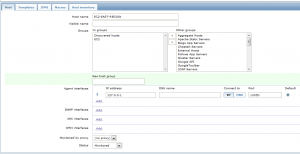Checking The Status Of Your ELB With Zabbix
In my current environment (not for this blog lol) I leverage multiple ELBs to provide multi availability zone HA. We also use Zabbix to monitor our EC2 environment (in a previous post I extended the Mikoomi EC2 Zabbix plugin) so I figured I would create a way to have Zabbix alert on outages with backend nodes configured in our ELBs.
Template
Here are the items which are configured in our AWS ELB Template:
- AWS Total Elastic Load Balancers
- AWS Number Of Elastic Load Balancers With Out Of Service Pool Members
- AWS Elastic Load Balancers With Out Of Service Pool Members
- AWS Instance IDs of Out Out Service Pool Members
The following is a list of “Triggers” which come configured with the template:
- An Elastic Load Balancer Has A Pool Member Out Of Service In {HOSTNAME}
Here is the Zabbix template which needs to be imported into your Zabbix Web Interface:
https://github.com/bcarpio/zabbix-aws-elb/blob/master/zbx_aws_elb_template.xml
ELB.py
To make the Zabbix template work you need to put the elb.py file on your zabbix server in the “ExternalScripts” location which is defined in your zabbix_server.conf file. On my system this is /usr/local/etc/zabbix/bin (but I modify my config specifically to this value).
This script requires the following options:
- -k – AWS Access Keys
- -s – AWS Secret Access Key
- -r – Region (us-west-1 or us-east-1, etc..)
- -n – Name – This is the NAME of the node as defined in your Zabbix web interface. For instance I define a node as US-EAST-1 and then assign the AWS ELB Template to that node
Here is the script:
https://github.com/bcarpio/zabbix-aws-elb/blob/master/elb.py
ELB.sh
For some reason I have a problem passing switches to script in the Zabbix web interface, so I simply wrote a wrapper around the elb.py script that sends the output of the elb.py script to a file, and then calls zabbix_sender to actually to a bulk send of the output of elb.py to the Zabbix server. This also needs to go into your “ExternalScripts” directory as defined in your zabbix_server.conf file:
https://github.com/bcarpio/zabbix-aws-elb/blob/master/elb.sh
Configure A Node In Zabbix
Finally you will want to configure a node in Zabbix which uses this script:
Next, you are going to want to define the following macros:
- {$AWS_ACCOUNT_ACCESS_KEY}
- {$AWS_ACCOUNT_SECRET_KEY}
- {$AWS_REGION}
Finally, you will simply attach the Template_Amazon_ELB_AWS to the US-EAST-1 host.
Hopefully this helps you with the monitoring of your AWS ELBs.
